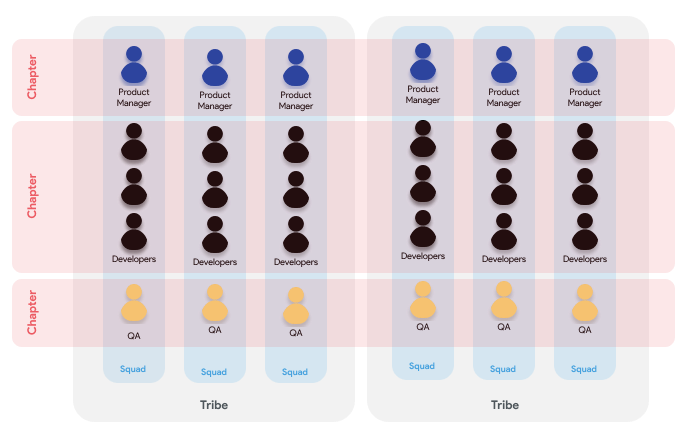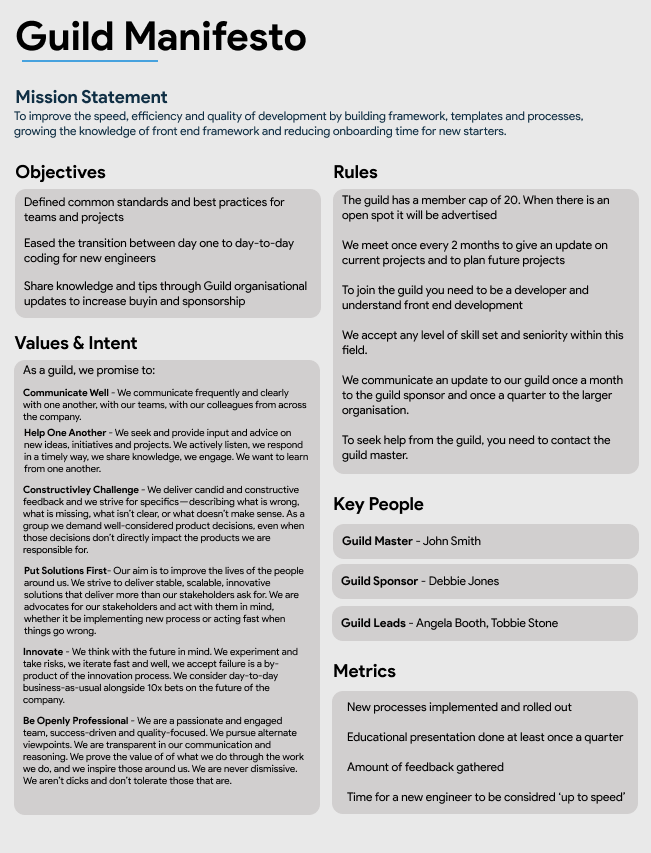
Many organisations have tried to adopt the ‘Spotify Model’ over the past few years. This is a framework made popular by Henrik Kniberg who at the time was an Agile Coach at Spotify.
What is the Spotify Model?
I previously wrote a a detailed overview post on the model and what it entails, which you can read to get up to speed here.
To summarise, the ‘Spotify Model‘ is a model made popular by Spotify and outlines their product delivery process, which focuses strongly on collaboration, understanding the customer and being able to ship as quickly as possible.
If we take a look at the Spotify Model, the main components of this framework are:
| Component | Description |
|---|---|
| Squad | A cross functional team that has a specific mission, goal and product to deliver |
| Chapter | Usually a team with the same skillset, for example product management, front end development, back end development, testing; and will usually have the same reporting manager. |
| Tribe | A tribe houses multiple squads. So a tribe will usually be a larger part/s of the product grouped together. |

What are Guilds?
Making an Impact Together
One of the additional core concepts of the framework is the Guild. Guilds sit out outside of the above listed components, and their objective is to form collaboration in a certain area, problem or topic. They are about building a community; and the main difference between a guild to chapters, tribes and squads is that the latter are all mandatory, where as guilds are voluntary .

They can sit across squads, tribes or teams, and anyone who has an interest of the desired skills can join.
I have seen examples of guilds such as:
- Product – if the team is decentralised
- Security
- Technology Frameworks
- Programming Languages
- Agile Delivery
- API
- User Research
- Innovation
Why Guilds Fail
There are many reasons why Guilds can fail. A lot of people see and like the idea from Spotify, and try to build them; and whilst their intentions are good execution is not quite there.
No Mission or Goal
Guilds have a better chance of sticking if they have an objective. Unfortunately, getting like minded individuals together without a cause is not a recipe for a successful guild. Its nice to have knowledge sharing and people sharing experience, skills and creating a community, and this might seem great at the beginning, but most guilds fizzle out because at the end of the day, they have no objective or struggle to make an impact.
Guilds need to focus on outcomes and not simply discussion. They need to measure outcomes by their impact on the guild’s mission, their benefit to the company, and their benefit to the community they are building. .
To remedy this, each Guild should first start out with a mission statement. What impact does the guild seek to achieve.
An example of a development language guild might be:
To improve the speed, efficiency and quality of development by building framework, templates and processes, growing the knowledge of [X] framework and reducing onboarding time for new starters.
Then supplement this by setting some objectives for the guild, or issues that the guild needs to address. For the same guild, some objectives might be:
- Defined common standards and best practices for teams and projects
- Eased the transition between day one to day-to-day coding for new engineers
- Share knowledge and tips through Guild organisational updates
- Reduce rate of errors and bugs
Guild Values
I find it also useful to set and document the values in which you want the guild to operate. These are less like rules that people need to follow, but more like the soft skills people need to have, code of conduct they need to follow and a baseline to help to find like minded people to ensure success.
Some examples of values might be:
- Communication – being explicit on how you expect people to communicate
- General respect for each other – how you expect people to be respectful to each other and no unprofessional behaviour is tolerated
- Helpfulness – how you expect guild members to help each other out, especially newer members to the guild
- Conflict & challenge – how the guild resolves conflict, and how you demand an environment of safety so innovation can happen, and people can feel confident to challenge ideas
Guild Charter / Rules
It’s important to set some ground rules for the guild, so members understand how to join, how to participate and maybe even requirements to stay in the guild.
Some things to consider are:
| Rule | Description |
|---|---|
| Membership Restrictions | Membership should be voluntary, but in order to get things off the ground you might want to push some team members to join to help get some traction. |
| Membership Numbers | How many members do you want to have in the guild? Is it unlimited or do you introduce a cap? Organising larger guilds with many members are much harder to maintain. |
| Membership Criterea | Is there any set criteria for joining the guild. Ideally you should not be restricting members based on department, seniority or location. Also consider skillset; if your guild has a specific objective that is technical in nature – maybe you need at least some of the members to hold specific skills. |
| Organisation | How do you want the guild to be organised? Does it have a single leader accountable for the success of the guild, or is there a group of people with shared responsibility? You might decide the leadership role rotates each quarter, or even you have the level of maturity to be completely self-organising. |
| Sponsorship | Do you want your guild to have a sponsor. The sponsor can help to guide initiatives that need to be delivered and also be a point of contact for obtaining insights, measurement and helping to realise impact being delivered. |
| Frequency | How frequent should the guild meet? Once a month, every week? This really depends on prioritising the needs of the guild with everyone else’s day job, buy in to even having guilds in place and people understanding its importance. It also depends on the type of work the guild is undertaking, so the frequency should adapt to that. |
| Communication Strategy | A successful guild should have a communication strategy. This I would split into 2 parts too, internal and external. For the first, how does the guild want to communicate within itself. Is it Slack, email, who needs to be updated on what. This is important to establish at the beginning so communication channels are there from the beginning and adhered to. Secondly, how does the guild communicate externally. How does it show the value it is bringing to the business and how does it communicate updates, progress and most importantly impact. |
| Governance | It’s also important to thing about how to govern the guild. How to ensure the rules are being followed. Governance is not just about following the rules though, it’s also measuring is the guild doing what it set out to do, circling back to its mission and objectives. |
Ensuring Success of the Guild
Tips for running a successful Guild
To help your guild to be successful and have some kind of longevity, I suggest the following:
- Getting endorsement and buy in from senior management. Having this is a first great step. They must understand the value that a guild can bring and be open to this method of collaboration and community. Its also important they allow the guild to be self-manning with how they operate and how they prioritise.
- Guilds must have a mission, vision some structure and a documented mandate. This allows not only the guild and its members to understand how to operate, but also educate externals on the guild, what it’s about and its current objectives. This will also reduce the risk of a second guild being created to try and sole the same or similar problems.
- Members need to take the guild seriously, understand that their contribution is vital and they must contribute to make the guild a success. The death of a guild can happen over time as members start to drop off and investment decreases.
- Ensure the guild frequently retrospects what it is doing and assess the value of it. For the guild to stay relevant and motivated, publishing progress and results is key, and even more important is celebrating those successes. This visibility can also inspire other guilds to form.
- Think about and be on top of the operational aspect of the guild. So clearly communicating meetings and their agendas. Who is mandatory and who is optional. Documenting meeting notes and sharing them etc. The more structure the longer the guild is likely to last.
Guild Manifesto
With all of the above, you should be able to build a Guild Manifesto. I would recommend that no guild is formed with some sort of document outlining its intentions. This can be a one slide or one page document, nothing too detailed and just gives a high level overview.
Here is an example:

Summary
There are many factors to why a guild fails, I believe the biggest one is no objective. You can get all the smart, likeminded people together that you want, but until they have a purpose the impact will be limited. Also without a mission, people will get bored or not see that contributing to the guild is worth their time.
There are some things that you can put in place to increase the success of your guild, such as documenting your objectives, having a mission statement and focusing a lot on the operations of the guild, ensuring it has structure, a framework and some rules of conduct for people to follow. Also, being part of a guild should be fun and exciting, so to balance that it’s important that the guild does not fall into too much bureaucracy.
Guilds may also run their course, and that’s OK too. Maybe a guild manages to reach its objectives, or completes what it set out to do. In that case, be content with putting a guild to bed and not dragging it out more than it needs to if that’s the case.
Finally, and most importantly, I suggest to make it your own. As I always state with any inspiration from the Spotify Model, its important to understand the problems you yourself are trying to solve, and adapt any solution to fit your need. Simply thinking having a guild is a good idea and trying to replicate it will likely not come with success. You don’t even need to call it a ‘Guild’, and maybe come up with a name or terminology that is consistent with what you already use within your organisation.
Social Media
Please follow me on social media for more content and updates:




